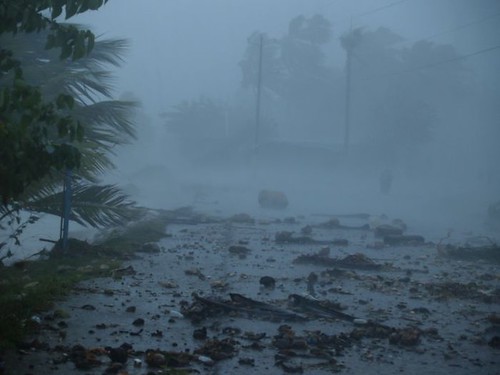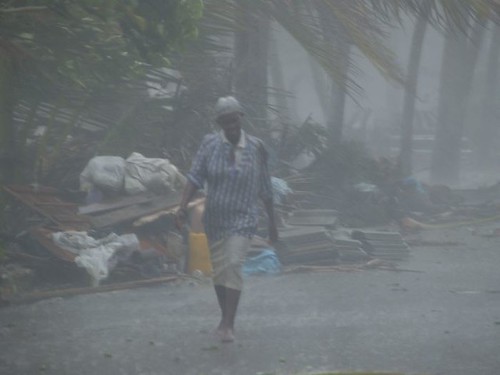JACMEL, Haiti — I attempted to call American Airlines for a good hour before getting through. When I did, they told me the inevitable; all flights out of Haiti had been cancelled due to Hurricane Dean. Earlier, I had spoken with the U.N. camera and video units, and they had all headed to Jacmel on the south side of Haiti to document the incoming storm and potential relief operations. Waiting in Port au Prince would have been the safer option, but Carmen and I decided that since we weren’t flying anywhere soon, we might as well see another part of the country and be where the action was. A three-hour drive later we were at the Cevadier, a solid hotel directly on the beach with a clear view of the incoming hurricane. We figured that if the U.N. was there, we were likely to be relatively safe or at least in a good position to be evacuated if things got really hairy.
Saturday evening was completely calm. The hurricane was supposed to brush Haiti at 8 p.m, but the time came and went with not even a hint of wind. We all retired to our rooms, happy for those Haitians living on the coast that the storm hadn’t yet materialized, if somewhat disappointed that the hurricane might pass in the night.
We needn’t have worried.
I awoke at 2 a.m. to the sounds of waves crashing against the coast. The outer bands of Dean had arrived. The sight of the roiled ocean surging onto the coast made me briefly question just how
intelligent this particular trip had been. The rest of the night was spent waking every hour to check the storm’s progress. With the exception of small blasts of wind, there was little rain. Only the swells to indicate what churned a few hundred miles offshore.
At daybreak I joined U.N. photographers Logan (Canadian) and Marco (Italian) to survey the night’s damage and see if the U.N. soldiers stationed in Jacmel had launched any rescue efforts for the many Haitians living in poorly reinforced houses built directly on the beach. Dozens had been either partially or completely destroyed from the storm surge, and several times we had to retreat as another surge swamped the houses we were surveying, spilling several feet of water into homes and continuing to eat away at their foundations. Still, there was no rain to speak of and, with the skies clear, by late morning it looked like the storm had passed.
Logan and I saw the clouds at the same time. Low, dark clouds off the coast, heading quickly towards land. The clouds were lit occasionally by bursts of lightning followed by the rumble of thunder. The air temperature dropped distinctly and the wind picked up strength. By the time we got to the car, sheets of rain were pouring down and the wind was battering the coast, whipping the coastal palms into a frenzy. On our drive back to the hotel, we had to weave around dozens of downed power lines, and the torrential rain was now bringing streams of muddy water from the mountains to meet the storm surge from the sea.

Near the coast at Jacmel (Aaron Ernst)
With the combination of the torrential rains from the back end of the hurricane and the continuing storm surge, the Haitians living on the coast will undoubtedly be heavily impacted. We have already seen concrete houses crumbled into the sea and many more full of water with their foundations giving way. There is no word yet of casualties, but a U.N. official I talked to expects there to be fatalities. I am back at the hotel and the lightning, thunder, rains and winds continue. Once the rains die down, we will head back out to get a more accurate survey of the impact of the outer bands of Hurricane Dean. Considering that Haiti was relatively far from the full fury of the hurricane’s winds, I truly hate to think what it holds in store for those in Jamaica who are squarely in Dean’s path.

A woman walking through the storm in Jacmel (Aaron Ernst)
